Source: Wild Hoofbeats
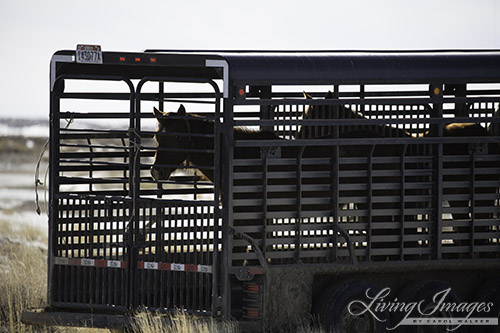
Only 3 mares in the trailer?
by Carol Walker, Dir. of Field Documentation for Wild Horse Freedom Federation
On Sunday morning I waited at the parking lot next to the corrals at the Rock Springs BLM facility. It was 1 degree above zero, and I was bundled up accordingly. I am the only member of the public there, unaffiliated with the BLM or University of Wyoming. One trailer and two trucks drive in front of me, and I am waiting for the other trailer. There are only 3 mares in this trailer, I am assuming three of the four mares that had radio collars put on on Friday. But there were 5 other mares that I had been told by Kate Schoenecker of USGS had not been collared because they were too young. In the Environmental Assessment, it states clearly that they were only going to collar mares 5 years old and older. Young mares who are still growing can be strangled by the collars. But where were the 5 other mares? They flagged me to follow, and I pulled out of the facility. When we took a break I asked where the other mares were. I was told they were still at the Rock Springs facility and they were being “re-evaluated.” What does that mean? They are either too young for the study, under 5, or they are not. Are they being kept for some other purpose? Both the EA and the BLM’s own press release state that none of the horses from Adobe Town are to be removed – they are all supposed to go back to the Herd Management Area. So what is the BLM not telling us?
These mares need to be released back to the area where they were trapped IMMEDIATELY.
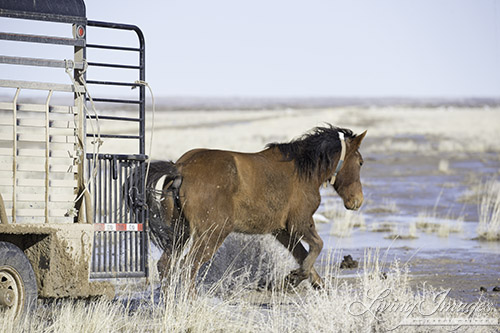
Robin comes out of the trailer
We drove to Bitter Creek Road, which is about 30 minutes from Rock Springs, and we started down the road. After we got off of the paved portion of the road, conditions got worse, from occasional mud to water and ice flooded areas. It was a challenging drive. After we passed Eversole Ranch, about 10 miles later the trailer stopped and the first mare was released, a little bay I named Robin. She ran as fast as she could once she hit the ground, only turning back to look at us when she had gone what she thought was a safe distance. There were no other wild horses in sight, and I learned that all three of the mares had been trapped about 30 miles south of this area.
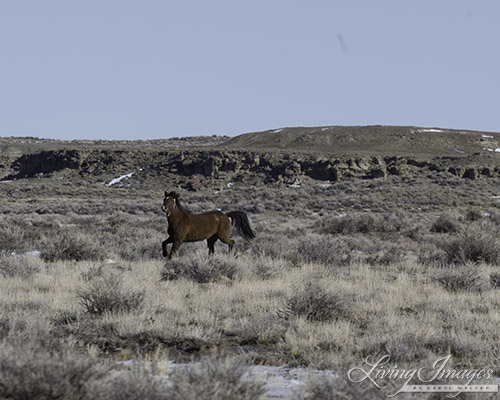
Robin looks back at us
We got back in our cars and continued driving for about 8 miles before stopping again to let another mare out of the trailer, this time a little sorrel I named Felicity. She turned around immediately after jumping out, looking for her friend, the grey mare in the back of the trailer. I noticed a cut over her eye that looked swollen. Any time you transport wild horses there can be injuries. It did not look deep and it did not prevent her from running off when one of the contractors shooed her away. There were no other horses around her either.
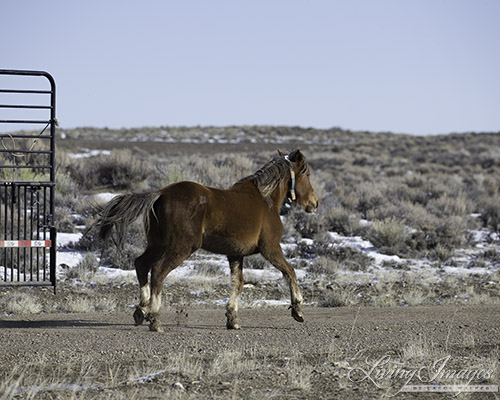
Felicity comes out of the trailer
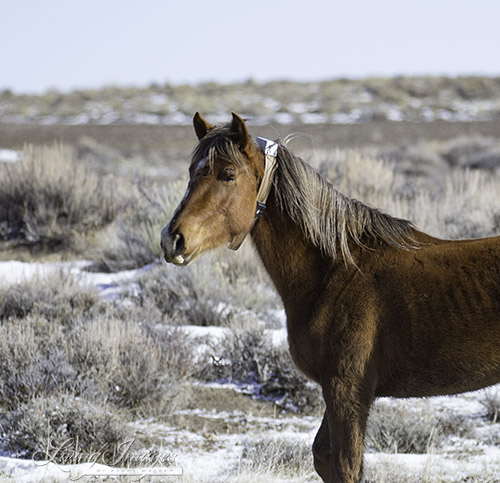
Felicity looks back at her friend in the trailer
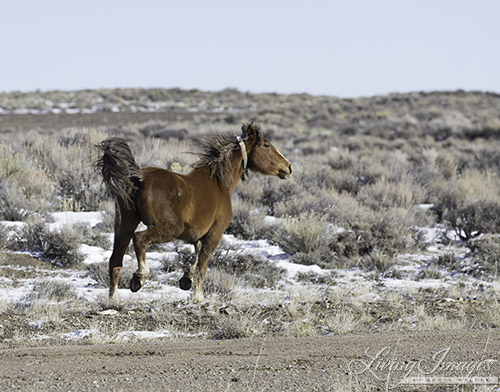
Felicity finally runs away
Read the rest of this story HERE, including this:
One thing that really puzzled me was that I saw piles of panels used for traps, all stacked on a semi. Neither team of contractors had a new trap set up. When I asked they told me some decision was being made at 7pm this evening, they did not tell me what. According to the BLM’s own web page on the bait trapping, they had trapped for only 5 days, starting Sunday February 5. They gathered by their own report 27 horses over the four days, and shipped 9 mares to the Rock Springs corrals. The information on the study in the EA said they would be trapping in 3-5 locations. Why then were they only trapping in two locations, and had not set up any traps after Thursday? In the EA, the BLM had written that if bait trapping “fails” they would go to a helicopter roundup. I hardly think that 5 days only is enough time to “fail.” it takes time to accustom wild horses to a trap and to let them get used to it and come in. That is what they are currently doing in Sand Wash Basin, where they have given far longer than 5 days to trap the horses. This seems to me to be a setup to fail. If they are not continuing to bait trap then they are getting ready to bring the helicopters in. Wild horses are injured and killed when driven with helicopters. There is no justification for subjecting the wild horses of Adobe Town to a helicopter roundup when they are not even over the Appropriate Management Level for their area.
The BLM should continue to use bait trapping if they have to finish getting 16 more mares for this ill-conceived research study, or better yet, they need to go back to the drawing board and redesign the study so that the researchers use non-invasive, safe direct observation, not dangerous radio collars.
Link to Daily Gather Reports:
Categories: Wild Horses/Mustangs









These Radio Collars are HUGE. Bigger than I thought they’d be…the BLM and USGA might as well have hung tires around the mares’ necks…and they think this big thing isn’t going to interfere with the mares natural behaviors of nuzzling etc.? Another hair brained idea by BLM to waste tax payer dollars.
LikeLiked by 1 person
And risk injuries to the horses.
LikeLiked by 1 person
Finding out where the rest of the mares ARE & whats happening to them is NO.1 – but another question is: why turn out one mare at a time AND why 30 miles away from where they came from? This whole crapshoot sounds so goofy – to put it mildly. AND if they collared 4 mares – why was the 4th mare left behind? In other words – what has happened to her! Suspicious? Darned right!
LikeLike
The 4th mare was picked up by the contractor in a different area, then taken to her family and released with them.
The rationale for not putting the three mares where they were trapped is they want to spread out the collared mares.
LikeLike
So ONE mare was actually released with her family! Where in this universe does it make sense to “spread out” the collared mares? Putting them in areas where they are alone – with no family or other horses to connect with? And this study(?) is being done by a college – where you would sort of expect a tiny bit of common sense at the least.
LikeLiked by 1 person
And I agree with you Maggie. Ideal would be to have no radio collars at all but putting the collars on at the trap site and releasing the mares with their families is the RIGHT way to do this.
LikeLike
Frankly – the whole “spreading out” of the 3 mares caused me to think more about the purpose for it. Do you suppose this is part of the experiment to see if the mares migrate back to their original home? Which is stupid – of course they will if its at all possible! More of the BLM’s & whatever “research” study – lets do this & see what happens!
LikeLike
Why the he** aren’t they putting the mares back in their original locations/herds? They are probably pregnant, and now alone and under maximum stress. What good is a study that shows isolated, panicky horses running all over creation trying to find their families?
Even worse to hear some considered too young are not being released, so there is a good chance they are being contracepted (chemically or surgically). Why else keep them and spend the time/gas/labor to haul only three horses back out onto the range in winter? Our tax dollars at work, folks. Not to even mention the data is private, not public, too.
LikeLiked by 1 person
You & I were both typing our comments at the same time, I guess, Icy!
LikeLike
I have heard from the BLM that there are in fact 4 mares and 1 stallion being held, not 5 mares, and they are being held since they are still capturing horses from the area they came from. They will be released “soon.”
LikeLike
Does the study protocol include anything about sterilizing the collars and facilities beforehand, and between horses? Rock Springs has had disease problems in the past, and taking horses from there back to the range could be a potential source of infection to naive wild herds. It’s unseasonably warm right now, and as you can see, there’s not much snow on the ground, so transmission is a consideration now when ordinarily in February it might not be.
LikeLike
Yes I am concerned about that as well, luckily it is still cold in Rock Springs.
LikeLike
Something smells. Keep on doing what you’re doing Carol and be sure to keep us posted. You rock!
LikeLike
BLM-Arshats with ancient brains. UGH
LikeLike
Just a matter of time before federal employees will be fitted with tracking devices?
All that’s needed is some grant $
Companies Are Putting Sensors On Employees To Track Their Every Move
Sociometric Solutions has created tracking devices for Bank of America, Steelcase, and Cubist Pharmaceuticals Inc., and is in talks with General Motors
http://www.businessinsider.com/tracking-employees-with-productivity-sensors-2013-3
LikeLiked by 1 person
Well, I know of a large group of federal employees that would make a wonderful research “study”! Would be enlightening!
LikeLiked by 1 person
The Quiet War Against Wyoming’s Wild Horses
ANDREW COHEN
https://www.theatlantic.com/national/archive/2011/08/the-quiet-war-against-wyomings-wild-horses/243286/
LikeLike
Yes this was a wonderful piece. I miss Andrew Cohen’s wonderful defense of our wild horses.
LikeLike
The BLM should not be allowed to do these roundups running them until exhaustion and even death. When is this going to stop? These helecoptor roundups are taking there toll on our wild horse’s. This is outrageous that our Government let’s this happen to these amazing wild horse’s. The BLM should be held accountable for there actions of animal cruelty. They just keep rounding up more and more. Stop at one place start at another. These horse’s were free and don’t deserve to be in this situation they are in. Rounding them up and separating bands, young foals pulled from there mother’s and left with no shelter in harsh weather conditions. Holding pens are crouded yet they keep bringing more and more . No more should suffer from these insane and cruel roundups. Leave “OUR” wild horse’s alone.
LikeLike
Flawed research does not further the reputation of either the University of Wyoming OR the researchers who are willing to be involved
OSU “missed fraud,” lost tenured professorship, Ivan on NPR’s Science Friday
The story is accompanied by a good roundup of the effects fraud can have on science,
http://retractionwatch.com/2013/01/06/catching-up-osu-missed-fraud-dipak-das-lost-tenured-professorship-ivan-on-nprs-science-friday/
LikeLike
Vying for grant money creates this problem and a system that only rewards departments that are able to obtain grants,
LikeLike
But, it becomes a “black eye” for universities to participate in these studies. There are many people who care about wild horses, and if they know what is happening, they
won’t want to pay the tuition money to a university that would participate in these types of experiments. They have a choice of universities and
would likely select another university. That’s why it is so important for all of you to share this article. Help get the word out. Radio collaring will likely be done on a much larger scale after these initial “studies” are done.
LikeLike
Probe by OSU missed fraud
Federal officials found evidence that more than 100 researchers nationwide committed misconduct over the past decade, and experts are certain that universities and other institutions underreport that fraud, which comes at an untold cost to taxpayers
The last record of any federal findings against an OSU researcher was in 2001, when the U.S. Public Health Service found that an assistant professor in the College of Dentistry plagiarized another researcher’s data in a federal grant application
http://www.dispatch.com/content/stories/local/2013/01/06/probe-by-osu-missed-fraud.html
LikeLike
If you look on Carol’s site at photos of the grey mare she named “Dove” being released, it looks like her collar is already upside down, and pretty far down her neck on release. What happens in this case? Are they designed to not harm a horse if hanging upside down for two years?
LikeLike
Who knows? When I asked how the collars would not end up being too tight when the mares gain weight in the summer months and when pregnant and was just to,d they “left room.”
LikeLike
Well. let’s hope “Dove” doesn’t try to scratch that thing off on a t-post from so far down her neck and upside down. I’ve seen horses nearly behead themselved doing this with just a nylon halter. Upside down the battery and receiver switch places, too, so who knows what effects that will have? Presumably they did extensive testing of these collars before producing what is being used, but no doubt in field conditions the horses will find unusual and unexpected ways to test them theirselves.
LikeLike
I am checking on that – according to the study info the collar is supposed to be right behind the ears, this one has slipped considerably below this – and is clearly loose which would make it easier to become caught on things, I am bringing photos with me tomorrow. This mare needs her collar to be dropped off, in my opinion.
LikeLike
Carol. bless you! That collar was upside down when they let her loose, so it should have been noticed earlier or released immediately. Keep us posted please.
LikeLike
Criticizing Animal Experimentation, at My Peril
Stephen F. Eisenman
Professor of Art History, Northwestern University, Evanston, IL, USA
But whatever the current opposition to reform, the changing ethical and scientific landscape suggests that experimentation on animals must dwindle and then disappear. New scientific understanding of animal awareness and consciousness – not just pleasure and pain but also anxiety, distress, anticipation, hope, empathy and even love – has enormously raised the stakes in the debate (Panskepp, 2012; de Waal, 2009; Griffin, 2001). It is no longer possible to assert that even the lowly laboratory mouse hasn’t the right to a life, or that its loss is a matter of indifference to it. Remarkably, these ideas – the result of developments in affective neuroscience and allied fields – have filtered down to the lay public faster than to most research scientists that work with lab animals. The result is growing pressure on universities to monitor, regulate, reduce and ultimately replace animals used in scientific experimenta¬tion. And the pressure on animal experimentation is not only from the public and the leaders of animal rights and welfare organizations; it is also from government and corporations – especially drug companies – that want safe, effective and prof¬itable drugs produced quickly. The real question now concerns the speed of change and how many animal (and human) lives will be lost in the meantime.
Click to access altex_2016_1_003_012_FFTEisenman2.pdf
LikeLiked by 2 people
Traditional Tracking vs. Electronic Surveillance: Has Wildlife Research Become Too High-Tech?
We now know more about the locations and wanderings of animal populations than at any other time in history.
That’s why it’s surprising to learn that old-time wildlife tracking — reading scats, chews, and paw prints – is making a comeback. Now, even as courses in natural history are being dropped at universities across the country, tracking clubs are flourishing in more than half of the United States, .
But wildlife radio tracking has created concerns as well as capabilities; it has provided opportunities for connection as well as for control. It’s been reported, for instance, that shock collars have been tested on wolves. When the wolves tried to roam beyond a fence of sensors controlled by a satellite, they were shocked. And as wolf management grows ever more controversial, biologists have also experimented with collars that contain tranquilizers, which can be activated remotely.
In some cases, collars turn out to be more than just metaphors for the forfeiture of freedom and wildness – they can also mean a loss of life. In one study, howler monkeys that were originally equipped with telemetry packs inside leather collars tried desperately to get them off. Many that did not succeed died. The reason was that howlers groom each other to control lethal parasites, and the collars interfered with the practice, thus spelling their doom.
That’s why some, mostly those in the public sector, are going retro. Old-fashioned wildlife tracking, they say, not only results in usable data but heightens awareness of sounds, smells, visual clues, and surroundings. In the field, each track and sign helps reconstruct a day in the life of an elusive animal. A hillside of what initially looks like dry, brown stones could actually be composed of porcupine dung, which means the place has probably been a den site for years. Wolf paw prints in the snow can tell the story of how an elk hunt was conducted with precision and strategic thinking on the part of the whole pack. These are things you wouldn’t see with transmitter technology.
http://goodnature.nathab.com/traditional-tracking-vs-electronic-surveillance-has-wildlife-research-become-too-high-tech/
LikeLiked by 1 person
Love this!!!! Good old fashioned observation in the field – nothing beats it!
LikeLike
May I suggest if this sort of “research” is to be conducted, we have collars put on some of the horses in LTH so the public can track there movements and whereabouts? Imagine if we had a couple of mares going to Scott City KS to die with a few hundred others, but the public had early warning? As it was even the BLM took a month or so to learn there were problems happening there.
LikeLike
They have done a study at Palomino Valley but studying horses in holding with collars and then concluding they are safe on horses in the wild is too big a leap.
LikeLike
Carol, agreed. I was suggesting it might provide one way for the public to monitor when and where horses in holding were being moved around, in real time. In other words, provide some equivalent “research” in the public interest.
LikeLike